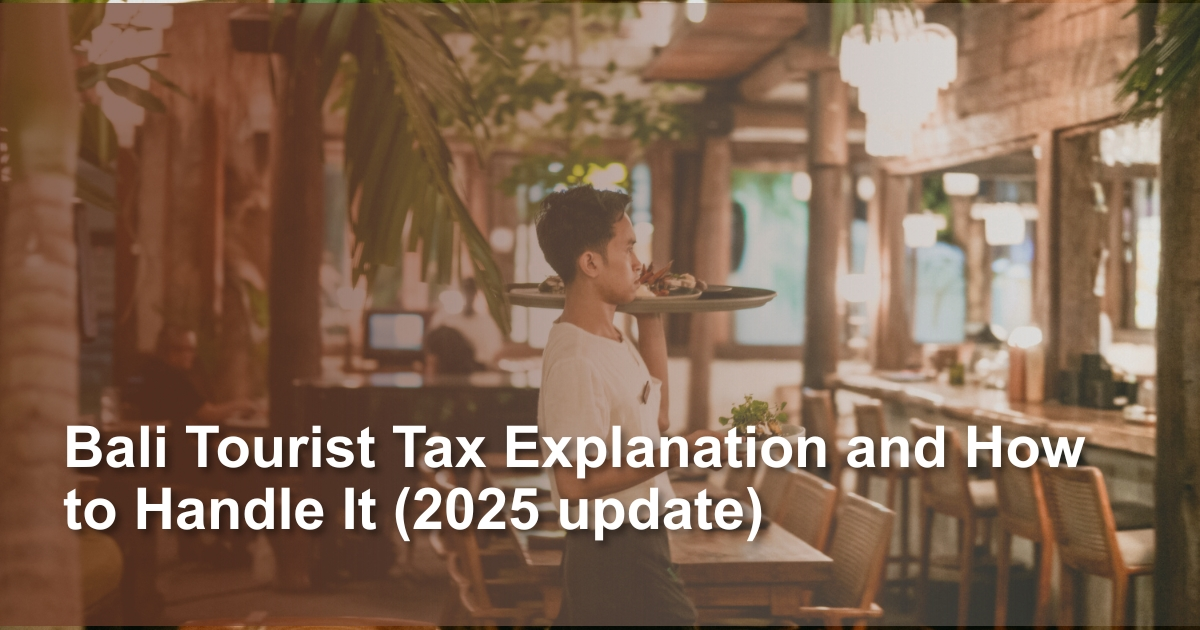A tourist tax is a fee that some destinations charge visitors to help support local culture, environment, and infrastructure. In 2024, Bali introduced its own version: a one-time levy for all foreign travelers. The goal is to preserve the island’s traditions and natural beauty while improving tourism facilities.
When I planned my trip, I wanted to be sure I understood the rules, so I checked Bali’s official regulations and provincial announcements. The requirement is straightforward: each foreign visitor pays IDR 150,000 (around USD 10 – 15) once per trip, either online before arrival or at official counters on entry. Knowing this in advance made my journey smoother, and in this guide I’ll break down everything you need to know, from payment steps and exemptions to where the money goes.
What the law says and where it comes from
The tourism levy for foreign visitors is established under Bali’s regional regulation for “Pungutan Bagi Wisatawan Asing” (Regional Regulation / Perda Provinsi Bali No. 6 of 2023), and the provincial governor issued implementing rules that explain how payment and administration must work (Governor Regulations / Pergub). The provincial websites and the formal Perda / Pergub documents set out the levy, its objectives, payment procedures, reporting, and administrative roles.
How much is the levy and when did it start?
The levy is IDR 150,000 per foreign visitor (roughly USD 10 – 15 depending on exchange rates). It was rolled out as a formal levy in 2024 and has been applied since February 14, 2024; the provincial tourism platform and official announcements list that amount and effective date. The proceeds are earmarked for protecting Bali’s culture and environment and for raising tourism quality.
All foreign visitors to Bali are subject to the levy. The rule is a one-time charge per visit to the province (you pay once per trip, not per day). The Perda and Pergub explain the scope and that electronic proof of payment will be issued when payment is completed. If you travel into Bali from another province of Indonesia, the levy still applies for that visit.
How and where to pay (step-by-step)
The provincial government set up an official payment platform (the LoveBali system) where visitors can pay online and obtain electronic proof (a barcode/receipt). Payment is intended to be cashless via the official system before or at arrival; counters and facilities for payment are also being installed at major entry points (airport and harbours) for travellers who could not pay in advance. Always use the official government site/app or the airport counters, third-party sites sometimes charge far higher “service fees.”
Practical steps I follow: pay online via the official LoveBali portal before I fly, save/print the receipt and a screenshot of the barcode, and keep the confirmation in my phone and email. If the site is temporarily down, pay at the official counter on arrival and keep that receipt.
Are there exemptions and how to apply?
Yes, the rules include specific exemption categories and a formal application process. Certain categories (for example official delegations, crew, or specific diplomatic statuses, see the regulation for precise categories) can request exemption. Requests for exemption generally must be submitted in advance (the implementing rules set timelines and documentation requirements; the governor’s implementing regulation explains the procedural steps). The regulation requires exemption requests to be submitted well before entry when applicable, and it sets out who reviews those applications. Always consult the official pages or your consulate if you think you qualify.
Enforcement, compliance and penalties (what the rules and reporting show)
The regional regulation gives the provincial government the authority to administer collection and to require proof of payment for access to some services and sites. Local press and government reporting show the levy is being implemented but that compliance has been a rollout challenge: collection rates were not 100% in the early period, and officials have emphasized increased monitoring and coordination with hotels, ports, airlines, and travel industry partners to improve collections. Authorities have warned that non-compliance could result in administrative measures such as denial of access to certain public services or attraction entry until proof is provided; enforcement practices and penalties are spelled out in the implementing regulations and follow administrative procedure.
What the levy pays for (officially)
The Perda and provincial communications state the levy is dedicated to protecting Bali’s culture, traditions and natural environment, funding programs for waste management, cultural preservation, and improving tourism infrastructure and services. The regulations require transparency and reporting on how the funds are used. That is the stated policy purpose, local government communications highlight projects and partnerships that the levy is intended to support.
Read also : Ensuring Smooth Entry: Bali Customs Rules & Guidelines
Common questions travellers ask (short answers)
Can I pay at the airport if I forget to pay online?
Yes. The official system includes counters at entry points so last-minute payments are possible, but to avoid queues and problems it’s recommended to pay online before travel and keep the receipt.
Does the charge apply to children and infants?
The regulation applies to “foreign tourists” as defined in the Perda; many official announcements stated the charge applies per foreign visitor without age exemption, so check the exact wording in the Perda and confirm with the LoveBali FAQs if you are travelling with infants. The public guidance has generally treated the levy as per person.
Can hotels or airlines charge me for it?
Payment is collected through the official electronic system, but the regulation allows cooperation with third parties (hotels, travel platforms) to collect payments on behalf of the provincial government. If a hotel or operator collects the levy, they should provide official electronic proof. Use only authorized collection channels to avoid scams.
What if the official website is down when I try to pay?
If the government site is temporarily offline, you can pay at designated counters at the airport or ports. Keep the receipt and proof of payment. Plan ahead where possible; check the official LoveBali site ahead of travel.
Practical Traveller Checklist
- Visit the official LoveBali page and pay the IDR 150,000 levy for each foreign traveller in your party; save the receipt and take screenshots.
- Keep both digital and printed proof of payment with your travel documents.
- If someone else (hotel, tour operator) will pay on your behalf, ask for a copy of the official electronic receipt/barcode.
- Avoid unofficial payment portals and intermediaries that advertise low fees or unofficial QR codes; use only government channels or trusted partners.
If you think you qualify for an exemption, start the exemption application at least a month before travel, as the rules require advance submission for some categories.
Where to check the legal text and official guidance
For legal details (exact wording, exemption categories, administrative sanctions, and how funds are managed) consult the published Perda (Peraturan Daerah Provinsi Bali No. 6 of 2023) and the Governor’s Regulations that implement it. For traveller-oriented guidance and the payment portal, use the LoveBali official pages; for implementation updates and press releases, check the Bali provincial government’s tourism and finance pages. Links to the Perda/Pergub and LoveBali FAQ are available via Bali’s official legal information systems and the LoveBali portal.
Read also : Which SIM Card Is Best for Tourists in Bali?
Final practical note (why I pay in advance)
I pay the levy online before I fly because it saves time and avoids the chance of being stopped for proof at an attraction or counter. The payment is modest, but it’s part of Bali’s current legal framework for tourism; paying and keeping the receipt is the easiest way to avoid trouble and help the fund’s stated aims. Also, paying through the official channel keeps you from getting ripped off by scam sites that mimic the payment page.










